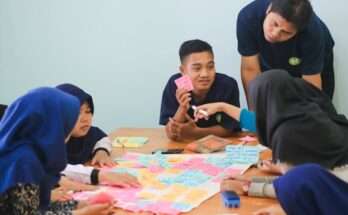What is Design Thinking in education, Design thinking describes a process of creative problem solving that has been adopted by many companies in recent years as an alternative to traditional business and marketing methods. In fact, it’s so effective that more and more companies are bringing it into their day-to-day practices, from pharmaceutical giants to small businesses across the country. Many school districts have begun to see the value in design thinking as well, using it not only to improve their curriculum but also to foster cross-disciplinary teamwork among students, teachers, and community members alike.
What is Design Thinking in education?
- Education can be made more engaging
- Benefits of using design thinking
- what is the purpose of design thinking
- Why design thinking works
- What is ideation in design thinking
- what is the design thinking methodology

Education can be made more engaging
Design thinking is a process of problem-solving by employing empathy and creativity. It starts with an observation, a question, or an idea. The word can be about anything that interests the designer, such as what students are doing in class, how they are feeling, or how they might feel if given new tools to do their work.
Designers then explore the problem from different perspectives and get feedback from other people on their ideas. They use this feedback to create prototypes (representations of possible solutions). They test these prototypes with more people to see which one works best and then design it accordingly. Design thinking has been used successfully in many fields – but only recently has it started being used in education. As designers, teachers must observe student behaviors and be empathetic towards them.
However, unlike designers who go through a rigorous process of testing and prototyping before designing something for the public, teachers often don’t have time to learn new pedagogies (teaching methods) because they already have too much content knowledge they need to teach. That said, there are some exciting initiatives happening in schools where principals give teachers time for collaboration; where everyone on staff shares responsibility for teaching children; where teachers take risks with their classrooms every day; where children become co-creators rather than just consumers of information. These projects show us what’s possible when we rethink school for 21st-century kids.
Benefits of using design thinking
Design thinking can be applied to any business, but it’s especially useful for startups. It’s a collaborative, hands-on process that begins with asking questions and looking at the world from different perspectives. There are also various design thinking frameworks that you can use to frame your thoughts and actions. For example, empathy maps help entrepreneurs better understand the needs of their customers. They are graphical representations of the experiences customers have with a particular product or service, breaking down how they interact with it into categories like emotions and pain points.
Empathy maps work by getting teams to imagine themselves as the customer and providing them with prompts like I want ____, I need ____, It makes me feel _____. Once someone fills out an empathy map on behalf of a customer, the whole team shares what they came up with. The map will show where there might be gaps in understanding between what the company thinks it’s doing right and what its customers need. From there, the team will have more insight into which direction they should take when developing their next project or product.
This process isn’t just helpful for startups. Even established companies can benefit from design thinking. For instance, if you’re an eCommerce site that frequently gets comments from customers saying that certain products don’t ship to certain countries, it would make sense to include those countries when choosing which products to stock. Not only does including these details increase sales, but it also reduces customer service calls and returns – something many businesses struggle with due to their large inventory and number of SKUs (or product codes). The design thinking process forces business owners or CEOs to take a fresh look at their businesses and customers from a different perspective. It forces them to ask why they do things as they do instead of accepting things as they are.
what is the purpose of design thinking
Design thinking is a process that helps identify the needs of a user and solves them. The process can be applied to many different fields, such as engineering, design, and even business. When the process is used in the field of design, it is often referred to as design thinking. The basic idea behind design thinking is to create something that has functionality and purpose but also takes into account human needs. This can be done by starting with an understanding of what will be used the most often or what problems need to be solved and making sure those are considered first.
While design thinking is not a difficult process to understand, applying it can be tricky. Since it’s not a set structure or set of rules, there are no strict guidelines on how to apply design thinking to different fields. However, there are general stages that anyone can follow when applying it. These stages include identifying problems and solutions for a particular group of people and understanding why these people have them. The designer might need to ask those who will use whatever they create questions like What do you want or need from me? while using observation techniques like surveys and interviews.
Why design thinking works
Design thinking works because it helps to bridge the gap between what the learner knows and what they need to know. It’s a way of thinking and of problem-solving that can be applied to any learning situation. The process starts with empathy, focusing on understanding the needs and feelings of others. Next, with design thinking, you go into ideation mode where you generate many possible solutions. With iteration, you narrow these down until you find one that solves the problem at hand. Finally, as an educator, it’s your responsibility to share this solution with others so that everyone benefits from design thinking’s focus on empathy and collaboration.
Most often, teachers begin by using design thinking with individual students. This kind of one-on-one session allows a teacher to get to know their student better and to understand what they need in order to feel successful. Then as a team, teachers can work together on group projects that use design thinking as a tool for problem-solving. In these settings, educators brainstorm possible solutions and select from them until they find something that works for everyone involved. A key component of design thinking is empathy; therefore, a focus on being inclusive should also take place. Achieving a balance of power will give students the chance to explore their creativity while also having ownership over what they create.
A balance of power also means that everyone gets credit for the final product which builds confidence in themselves and other people around them. Students should not have to worry about hurting someone else’s feelings or living up to someone else’s standards, but rather finding out who they are through creative expression.
What is ideation in design thinking
The process of design thinking starts with ideation, which is the act of envisioning a future state and exploring opportunities to get there. A good ideation session starts with asking questions like: What is our goal? How will we know if we achieved it? Who cares about this? and What are our constraints?. For example, a school district may be considering an idea for how to improve student test scores, in which case they might ask themselves questions like: What would a high-performing school look like? How will we know if students are achieving those outcomes? Who cares about these outcomes? etc.
So how do we start ideation? The first step is to understand what you are doing. Design thinking is an approach to solving problems and coming up with ideas that do not ignore user needs and constraints, but allow for creative solutions. It involves divergent thinking to generate as many possibilities as possible followed by convergent thinking to choose a solution that would work best. Ideation sessions can be conducted through brainstorming or surveys among users and stakeholders. Stakeholders have different needs so it’s important to get their input early on in order to incorporate them into your design before you spend resources and money building it.
what is design thinking methodology?
Design thinking is a process of synthesis that is used to create innovative solutions for problems. It is a cross-disciplinary, collaborative, and research-based approach to design that involves the whole problem-solving process from identifying the need to determining the best solution. The design thinking methodology consists of five phases: empathize, define, ideate, prototype, and test. Empathize with stakeholders by understanding their needs and motivations. Define the problem by understanding its context and constraints. Ideate potential solutions by researching existing solutions, generating ideas, and testing them against the defined problem criteria. Prototype possible solutions with quick sketches or wireframes or low-fidelity prototypes to understand what works best when they are closer to being implemented in reality.
The design thinking methodology is a great way to approach complex problems and come up with innovative solutions. It involves observing users, defining needs and requirements, and designing potential solutions which can then be prototyped and tested to see if they will work out. Empathy enables you to develop empathy towards people who might use your product. A successful product requires empathy as well as creativity and analytical skills. The key difference between design thinking and other methods is that it looks at the whole problem rather than just one aspect of it. Designers always have a holistic perspective on things which helps find new insights into products




